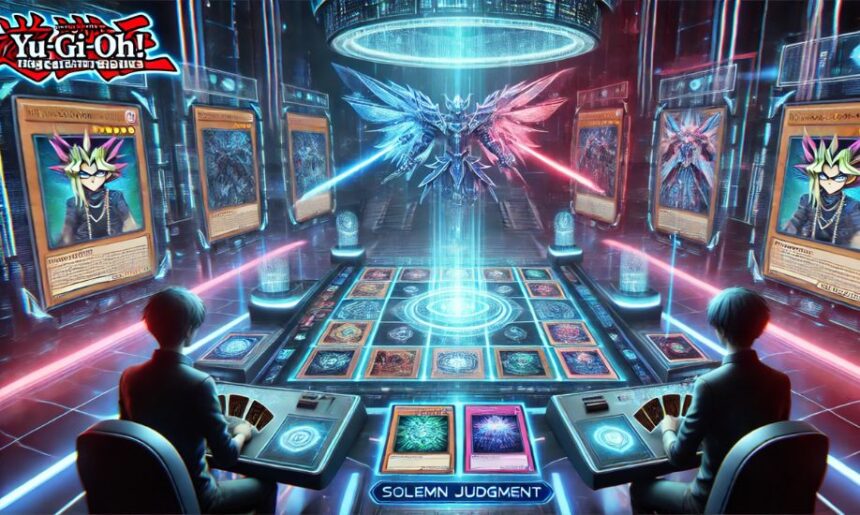Are the Solemn Cards Bad in 2034?
In the ever-evolving world of Yu-Gi-Oh!, strategies and archetypes continue to adapt to meet the demands of changing metagames. One question that has sparked much debate in 2034 is: Are the Solemn Cards bad in 2034? This article analyzes their relevance, utility, and role in the modern game while addressing key factors that influence their current viability.
The History and Significance of Solemn Cards
Solemn Cards have long been recognized as some of the most iconic trap cards in Yu-Gi-Oh! Known for their potent negation capabilities, these cards—including “Solemn Judgment,” “Solemn Warning,” and “Solemn Strike”—have shaped countless duels. “Solemn Judgment,” in particular, stands out as a historic staple, offering the ability to counter virtually any play, albeit at the high cost of half the player’s Life Points.
Historically, these cards were essential in control decks, enabling players to disrupt critical plays and dominate the battlefield. However, the 2034 metagame presents unique challenges that have altered the perception of these once-indispensable tools.
Are the Solemn Cards Bad in 2034? Evaluating Their Drawbacks
Life Point Costs
The Life Point costs associated with Solemn Cards have always been a double-edged sword. In 2034, where the metagame is faster and more aggressive, these costs can be particularly punishing. Losing half your Life Points for “Solemn Judgment” or paying 2,000 for “Solemn Warning” can put players at a significant disadvantage, especially when matches often hinge on maintaining momentum.
Power Creep and Modern Alternatives
The concept of power creep has introduced newer cards that rival or surpass the utility of Solemn Cards. Cards like “Infinite Impermanence” provide similar negation effects without Life Point costs, while hand traps such as “Ash Blossom & Joyous Spring” offer proactive disruption. These modern tools are often preferred due to their efficiency and versatility.
Speed of the Game
The 2034 metagame is dominated by high-speed, combo-heavy decks capable of overwhelming opponents in a single turn. Solemn Cards, while powerful, are inherently reactive. This makes them less effective against fast-paced strategies where missing a single critical play can lead to a swift defeat.
Situational Strengths of Solemn Cards in 2034
Despite these criticisms, Solemn Cards are far from obsolete. Their unique advantages ensure they remain relevant in certain scenarios.
Universal Negation
One of the greatest strengths of Solemn Cards is their broad application. “Solemn Judgment” can negate any spell, trap, or summon, making it a versatile option in critical situations. This level of flexibility remains unmatched by many modern alternatives.
Control Decks
Solemn Cards thrive in control-focused strategies, where their negation power can be used to stifle the opponent’s key moves. In these slower, more deliberate decks, the Life Point cost is less of a drawback compared to the potential payoff.
Game-Changing Impact
A timely “Solemn Judgment” or “Solemn Strike” can completely alter the course of a duel. These cards’ ability to neutralize pivotal threats makes them valuable tools in a skilled player’s arsenal.
Comparing Solemn Cards to Modern Alternatives
To fully address the question of their relevance, it’s important to compare Solemn Cards to popular modern alternatives in 2034:
- Infinite Impermanence: Provides negation without Life Point costs and can be activated from the hand, offering a level of surprise.
- Ash Blossom & Joyous Spring: Disrupts the opponent’s deck-searching or drawing capabilities, making it a proactive form of control.
- Crossout Designator: Targets specific threats, allowing for precise counterplay in a way that complements reactive strategies.
While these alternatives excel in speed and efficiency, Solemn Cards retain their edge in raw power and versatility.
Are the Solemn Cards Bad in 2034? The Collector’s Perspective
Beyond their use in gameplay, Solemn Cards hold significant value in the collector’s market. As iconic staples from Yu-Gi-Oh!’s rich history, they are prized for their nostalgic and aesthetic appeal. Rare and first-edition versions, particularly holographic prints, fetch high prices among collectors, ensuring their legacy extends beyond competitive play.
The Verdict: Are the Solemn Cards Bad in 2034?
Determining whether Solemn Cards are bad in 2034 depends on the context. For competitive players, their drawbacks in speed and cost-efficiency make them less appealing compared to modern alternatives. However, they remain potent tools in control decks and niche scenarios. Additionally, their historical and collector’s value cements their place as beloved artifacts of the game.
To label Solemn Cards as outright bad oversimplifies their role. While they face significant challenges in the current metagame, their utility and enduring legacy ensure they remain relevant to the Yu-Gi-Oh! community.
FAQs About Solemn Cards in 2034
Why do people consider Solemn Cards bad in 2034?
Solemn Cards are criticized for their high Life Point costs, slower activation compared to modern alternatives, and difficulties in adapting to the fast-paced metagame.
Are Solemn Cards still viable in competitive play?
Yes, they can still be effective in control-based strategies or specific scenarios where their negation power can disrupt key plays.
What alternatives to Solemn Cards are popular in 2034?
“Infinite Impermanence,” “Ash Blossom & Joyous Spring,” and “Crossout Designator” are widely used due to their efficiency, speed, and versatility.
Do Solemn Cards hold collector’s value in 2034?
Absolutely. Rare editions and pristine copies of Solemn Cards are highly sought after by collectors, often commanding premium prices.
Should I include Solemn Cards in my deck in 2034?
It depends on your strategy. Control-oriented decks can still benefit greatly from Solemn Cards, but faster, combo-heavy decks may find modern alternatives more suitable.







